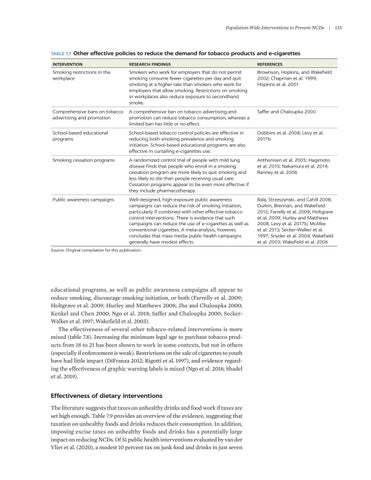Population-Wide Interventions to Prevent NCDs | 133
TABLE 7.7 Other
effective policies to reduce the demand for tobacco products and e-cigarettes
INTERVENTION
RESEARCH FINDINGS
REFERENCES
Smoking restrictions in the workplace
Smokers who work for employers that do not permit smoking consume fewer cigarettes per day and quit smoking at a higher rate than smokers who work for employers that allow smoking. Restrictions on smoking in workplaces also reduce exposure to secondhand smoke.
Brownson, Hopkins, and Wakefield 2002; Chapman et al. 1999; Hopkins et al. 2001
Comprehensive bans on tobacco advertising and promotion
A comprehensive ban on tobacco advertising and promotion can reduce tobacco consumption, whereas a limited ban has little or no effect.
Saffer and Chaloupka 2000
School-based educational programs
School-based tobacco control policies are effective in reducing both smoking prevalence and smoking initiation. School-based educational programs are also effective in curtailing e-cigarettes use.
Dobbins et al. 2008; Levy et al. 2017b
Smoking cessation programs
A randomized control trial of people with mild lung disease finds that people who enroll in a smoking cessation program are more likely to quit smoking and less likely to die than people receiving usual care. Cessation programs appear to be even more effective if they include pharmacotherapy.
Anthonisen et al. 2005; Hagimoto et al. 2010; Nakamura et al. 2014; Ranney et al. 2006
Public awareness campaigns
Well-designed, high-exposure public awareness campaigns can reduce the risk of smoking initiation, particularly if combined with other effective tobacco control interventions. There is evidence that such campaigns can reduce the use of e-cigarettes as well as conventional cigarettes. A meta-analysis, however, concludes that mass media public health campaigns generally have modest effects.
Bala, Strzeszynski, and Cahill 2008; Durkin, Brennan, and Wakefield 2012; Farrelly et al. 2009; Holtgrave et al. 2009; Hurley and Matthews 2008; Levy et al. 2017b; McAfee et al. 2013; Secker-Walker et al. 1997; Snyder et al. 2004; Wakefield et al. 2003; Wakefield et al. 2006
Source: Original compilation for this publication.
educational programs, as well as public awareness campaigns all appear to reduce smoking, discourage smoking initiation, or both (Farrelly et al. 2009; Holtgrave et al. 2009; Hurley and Matthews 2008; Jha and Chaloupka 2000; Kenkel and Chen 2000; Ngo et al. 2018; Saffer and Chaloupka 2000; SeckerWalker et al. 1997; Wakefield et al. 2003). The effectiveness of several other tobacco-related interventions is more mixed (table 7.8). Increasing the minimum legal age to purchase tobacco products from 18 to 21 has been shown to work in some contexts, but not in others (especially if enforcement is weak). Restrictions on the sale of cigarettes to youth have had little impact (DiFranza 2012; Rigotti et al. 1997), and evidence regarding the effectiveness of graphic warning labels is mixed (Ngo et al. 2018; Shadel et al. 2019).
Effectiveness of dietary interventions The literature suggests that taxes on unhealthy drinks and food work if taxes are set high enough. Table 7.9 provides an overview of the evidence, suggesting that taxation on unhealthy foods and drinks reduces their consumption. In addition, imposing excise taxes on unhealthy foods and drinks has a potentially large impact on reducing NCDs. Of 51 public health interventions evaluated by van der Vliet et al. (2020), a modest 10 percent tax on junk food and drinks in just seven

